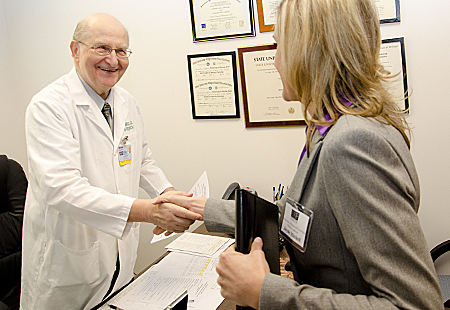Practice makes perfect for student interviews

The beginning of the next stage of their life starts now.
Soon, the medical students of the class of 2012 will criss-cross the country, dressed in their business best, nervously anticipating curveball questions and first impressions, as they start their interviews.
The interviews will chart the course of their future, as they are a key step in determining where they will go to receive their graduate medical education.
“It’s a little nerve-racking,” says Jayme Mitchell, a fourth-year USF medical student who hopes to become an OB/GYN physician. “But it’s also exciting.”

Mitchell and her fellow would-be OB/GYNs are receiving a little help tonight, thanks to USF’s Department of Obstetrics and Gynecology and several faculty members. Seven students have dressed in their interview clothes this evening for a full round of mock interviews.
The department’s leaders do the mock interviews each year to try to give the students a little extra practice before they head out to residency programs around the country. USF’s Office of Student Affairs also coordinates a program of mock interviews with volunteer faculty members.
“They always worry,’’ said Dr. Jimmy Mayer, associate professor and director of Undergraduate Women’s Healthcare Education. “They always have a ton of questions about the interview itself.”
Medical students have become experts at taking written tests over the years, but the thought of this new kind of assessment fills some with dread. They ask Dr. Mayer about all their uncertainties.
What questions will they ask me? What should I tell them? How many interviews should I do?
The mock interviews are designed to soothe nerves, give students a boost of confidence and a better idea of what to expect.

The timing couldn’t be better for student Delaura Patel.
“My first interview is on Friday,” she said. “I’m flying to Arizona. This is like the real thing.”
The department tries to make the interviews as much like the real thing as possible, said Dr. Mayer and Lauren Shaw, coordinator of Undergraduate Women’s Healthcare Education. Dr. Mayer warns students that each program is different; others may not run their interviews in the same way as USF’s. To avoid potential bias, any students who do mock interviews will be matched with other faculty members if they interview for USF residencies.
The students are so hungry for extra experience that they have juggled busy clerkship schedules to be here. Robert Rossi is working nights right now and went to bed at 9 a.m. But he’s here this evening in his best suit.
“I like this,” Rossi said. “I need the practice.”
There are advantages to practicing on the home court. When Mitchell walks into her final interview, it’s easy to greet Dr. Soha Patel, a first-year resident, with assurance.
“Obviously, we’ve never met before,” joked Dr. Patel.

Dr. Patel grills Mitchell on her medical interests: Why do you like the program here? Are you concerned that your experience might be more narrow if you stay in one place? Where do you see OB, as a field, going ten years from now?
She throws in a few offbeat, more personal queries as well: Who inspires you? Who do you rely on most? Tell me about your favorite childhood moment. What’s the last thing you Googled?
Mitchell handles the curve balls with ease. Staying put doesn’t worry her, she says, because USF is constantly changing and adapting. And the person closest to her: Mom.
The students also get other tips about what happens outside the interview room. Cluster your interviews by location so you don’t have to buy as many plane tickets. Remember coats and shoes for winter weather. The reception the night before can be just as important as interview day – and if residents don’t show, that may be a red flag that they’re unhappy with the program.
Mitchell has wanted to become an OB/GYN since shadowing a family friend in high school.

“It’s exciting, it’s fast paced,” she said. “I feel like I can connect with the patients – and that they trust me. It’s fun delivering babies, but there’s a lot more than that too.”
– Story by Lisa Greene, photos by Eric Younghans, USF Health Communications

